February itinerary in Japan Day 3 (Hyogo, Tottori)
(Friday, February 25)
Table of contents
2. Hyogo Park of the Oriental White Stork
4. Tottori Castle Ruins, Jinpukaku
5. Minoura family samurai gate
7. Tottori City History Museum
1. Sakataru Shrine
I took a taxi to Sakataru Shrine in the morning of February 25. I really wanted to go to Hyogo Park of the Oriental White Stork by bus, but I missed the bus, so I had no choice but to take a taxi to Sakataru Shrine at the end of Hyogo Park of the Oriental White Stork. However, this led to a lucky event as described below. As a result, it was all right.
As the name suggests, Sakataru Shrine is a shrine related to sake. The god of worship is Sakamizuo no Mikoto and Sakamizume no Mikoto, the ancestor of Toji and the guardian deity of the sake brewer.
I couldn’t go this time, but in Toyooka City, there is a shrine called Nakajima Shrine that enshrines the gods of sweets (Tajimamori), and is revered by confectionery companies nationwide. The main shrine of Nakajima Shrine is an important cultural property of Japan.
The main shrine of Sakataru Shrine was completed in 1449. The main shrine is designated as a national important cultural property because the design of the Muromachi period is valuable. However, I couldn’t take a closer look at the main shrine because it was protected by a covering roof and the deep snow in the precincts was to get close to the main shrine.
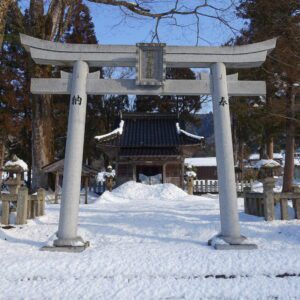
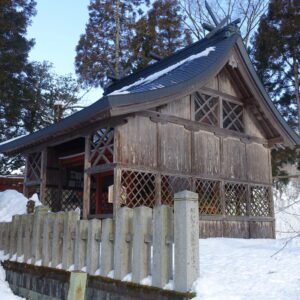
2. Hyogo Park of the Oriental White Stork
When I was walking to “Hyogo Park of the Oriental White Stork“, which is a 20-minute walk from Sakataru Shrine, I found a wild white stork in an ice-covered rice field. It is said to be a vigilant bird, but the white stork stayed still, even when I approached it to a distance of 20-30 meters. The white stork stayed still for a while, but as soon as I put the camera in my bag, the white stork took off and I couldn’t take a picture of it flying.

As mentioned earlier, I missed the bus, so I was able to see a wild white stork. White Storks are said to carry happiness in both Japan and Europe, so it was a lucky event from the morning.
The stork is designated as a national special natural monument. It is a big bird that can reach up to 2m when both wings are spread.
White storks are similar to cranes, but in a completely different biological category. Cranes are Gruiformes and white storks are Ciconiiformes. Ciconiiformes are more closely related to Pelecaniformes. The big difference between white storks and cranes is that white storks stop ringing as they grow up, but cranes ring loudly. There is also a big difference in nesting, where white storks are built on high places such as on trees, and cranes are built on the ground. Cranes run on the ground and fly, so they do not stop on trees.
“Hyogo Park of the Oriental White Stork” was opened in 1999 as a research institute that protects and proliferates white storks, a national special natural monument, and practices reintroduction to the wild. We can observe breeding white storks in the open area of the park. Breeding white storks have some of their feathers (such as hair and nails in humans) cut off, so they cannot fly away. However, it seems that it is necessary to cut the feathers regularly because the feathers grow. It’s just like human hair and nails.

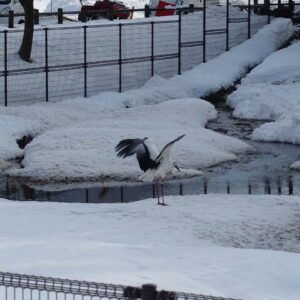
By 2019, 53 white storks were released outdoors after being bred in Hyogo Park of the Oriental White Stork, and now they are flying not only to Hyogo prefecture but also to 47 prefectures nationwide.
The mailbox at the entrance of “Hyogo Park of the Oriental White Stork” was shaped like a white stork sandwiching the mailbox.

3. Walk around Toyooka city
Toyooka City was hit by the North Tajima Earthquake with a seismic intensity of 6 in 1925 (two years after the Great Kanto Earthquake). The earthquake killed 428 people, completely destroyed 1,733 houses, and partially destroyed 2,106 houses. After that, many buildings were built as “reconstruction architecture” for reconstruction, and those buildings still remain.
The “Toyooka City Hall Former Main Government Building (former Toyooka Town Hall)” built in 1927 is a building with beautiful white walls. It is currently used as a house for the Toyooka City Council and a space for civic center.
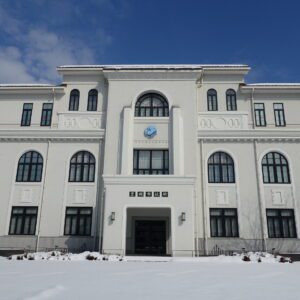
“Auberge Toyooka 1925” was built in 1934 as “Hyogo Agricultural and Industrial Bank Toyooka Branch”. It is a national tangible cultural property. “Auberge Toyooka 1925” is named after 1925, when the Great North Tajima Earthquake struck.
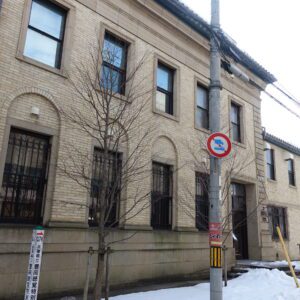
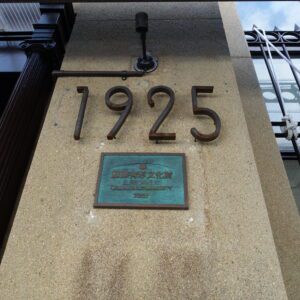
There are three reconstruction buildings on Saint-Stoke Avenue. It is one of the representative buildings of earthquake disaster reconstruction architecture.
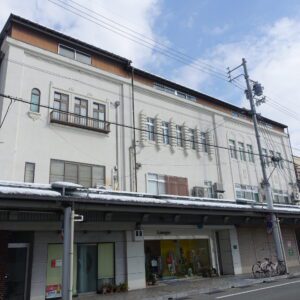
In addition to the ones I introduced, there are various reconstruction buildings in Toyooka City. I didn’t have enough time this time, so I couldn’t go around enough, but if I have another chance, I would like to take a leisurely stroll around Toyooka city.
4. Tottori Castle Ruins, Jinpukaku
After lunch, I headed from Toyooka station to Tottori station. The trains I used are as follows.
Depart Toyooka Station at 11:43, Limited Express Kounotori No. 3, arrive at Kinosaki Onsen Station at 11:52
Depart Kinosaki Onsen Station at 11:56, San-in Line “bound for Tottori”, arrive at Tottori Station at 13:54, total fare Yen 2,710
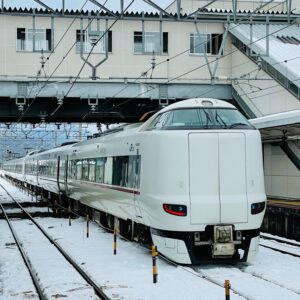
Even though it was a weekday from Kinosaki Onsen Station to Tottori Station, the trains were quite crowded and the seats were about 70% full. On the way, a considerable number of passengers got off at Amarube Station, which is just past the Amarube Viaduct. The Amarube Viaduct is the second generation, but the scenery of the Amarube Bridge still seems to attract tourists. Next time, I also wanted to get off at Yobe Station and enjoy the scenery.
It was a fun trip from Kinosaki Onsen Station to Tottori Station while watching the snowy countryside.
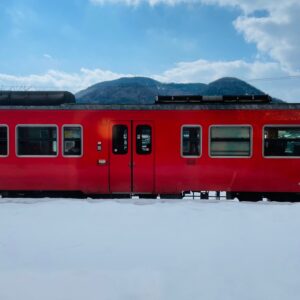
Upon arriving at Tottori Station, a huge umbrella used for the summer festival “Shanshan Festival” was on display. By the way, Tottori station was not an automatic ticket gate. In addition to Tottori Station, Yamaguchi Station, Matsuyama Station, and Tokushima Station are the only stations where automatic ticket gates have not been introduced at the prefectural capital.
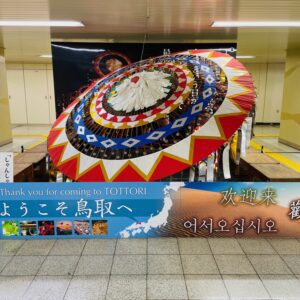
After arriving at Tottori Station, I checked in at the hotel and took a bus to the Tottori Castle Ruins and Jinpukaku. The buses I used are as follows.
Depart Tottori Station 14:10, Hinomaru Bus “bound for Sakyu Kaikan”, arrive at Nishi-machi 14:17, fare Yen 170
Tottori Castle ruins are the ruins of a castle that originated from a mountain castle during the Warring States period. From the long history of Tottori Castle, you can see the stone walls of various castles from the Middle Ages to the early modern period and modern times. Therefore, the ruins of Tottori Castle are called “Museum of the Castle”. In addition, it has been selected as one of the 100 Fine Castles of Japan by the Japan Castle Association.
Tottori Castle is also a tragic castle where many people died of starvation due to the starvation tactics of Hideyoshi Hashiba (Hideyoshi Toyotomi). At the time of this starvation tactics, the castle owner, Kikkawa Tsuneie, opened the castle in exchange for Seppuku (Harakiri). There is a statue of Kikkawa Tsuneie in the immediate vicinity of Tottori Castle.
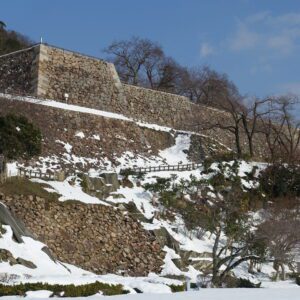

“Historic site Tottori Castle Ruins Taikoganaru” is a national designated historic site.
“Jinpukaku” is a Western-style building built on the ruins of a castle and is a national important cultural property. “Jinpukaku” was built in 1907 as the villa of the Ikeda clan, the lord of the Tottori domain. “Jinpukaku” was designed by architect Katayama Tokuma. He designed the current national treasure, the Guest House Akasaka Palace. “Jinpukaku” is a two-story white wooden tiled roof. The “spiral staircase” has no columns. It’s a wonderful curvaceous beauty.


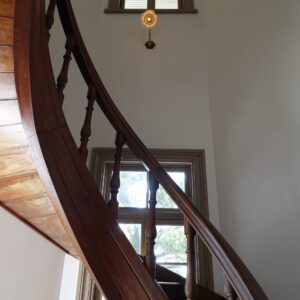
The frame on the second floor of “Jinpukaku” was written by Heihachiro Togo, who named “Jinpukaku”.
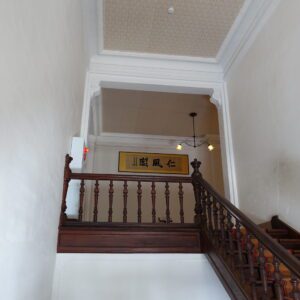
In “Jinpukaku”, the Kirin lion head used for the Shishimai (lion dance) that has been handed down from ancient times in Inaba Province (currently eastern Tottori Prefecture) was exhibited. The Shishimai using Kirin lion head have started at the Gongen Festival in 1650 when the first Tottori feudal lord, Mitsunaka Ikeda, built the Tottori Toshogu Shrine (Ouchidani Jinja). It has been designated as a national important intangible folk cultural property and has been designated as a Japanese heritage site as “Kirin no Machi“.
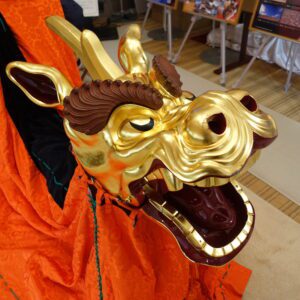
Admission: Yen 150 for adults
5. Minoura family samurai gate
The Minoura family samurai gate is the nagayamon of the Minoura family who was a senior samurai of the Tottori domain. It is located between “Jinpukaku” and “Tottori Toshogu”. The Minoura family samurai gate is a 10-minute walk from Jinpukaku. It is designated as a protected cultural property designated by Tottori City because it is valuable as the remains of the only samurai nagayamon that remains in Tottori.
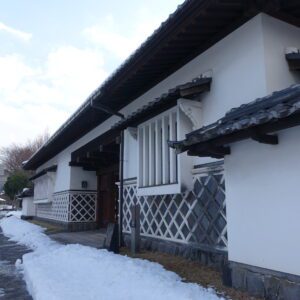
6. Tottori Toshogu
Tottori Toshogu Shrine (Ouchidani Jinja) was built in 1650 by the first Tottori feudal lord, Mitsunaka Ikeda, as a spirit of Nikko Toshogu. Mitsunaka Ikeda is the grandson of Terumasa Ikeda, the first feudal lord of the Himeji Domain in Harima, and the great-grandson of Ieyasu Tokugawa. It is about a 15-minute walk from the Minoura family samurai gate.
The four buildings of the main shrine, worship hall, heiden, and Karamon of Tottori Toshogu are national important cultural properties. It was a luxurious time to be able to see the historic buildings of Tottori Toshogu in a quiet precinct where no one but me.
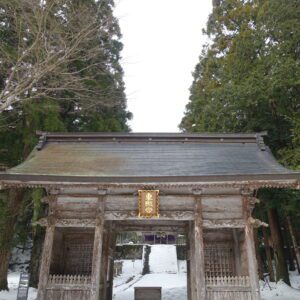
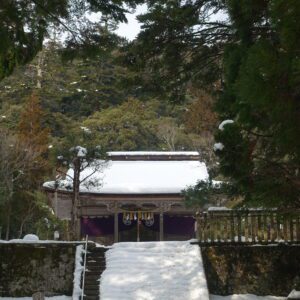
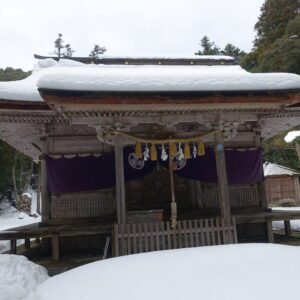
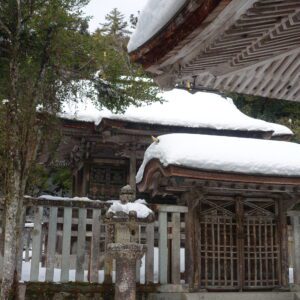
7. Tottori City History Museum
A special exhibition “The World of Nishiki-e II” was held at the Tottori City History Museum, which is located just off Tottori Toshogu Shrine. Admission was free.
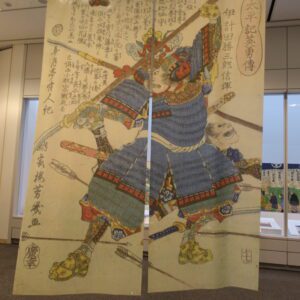
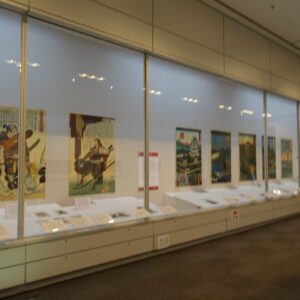
8. Fukuda family residence
I went to the Fukuda family residence by bus from the Tottori City History Museum. The buses I used are as follows.
Depart Uchiyoshi-gata at 16:06, Nihon Kotsu 75 Tsunoi Wakabadai Circulation Line “bound for Sakuragaoka Wakabadai Minami 1-chome”, arrive at Kaizoji at 16:20, Fare Yen 250
It’s less than 10 minutes on foot from the Kaizoji bus stop, but I had a hard time walking on a snowy road.
The Fukuda family is a family of pedigree who served as Oshoya (village headman) in the former Tsunoi village for 20 generations. The construction period of the Fukuda family residence is estimated to be from the end of the Muromachi period to the beginning of the Edo period, and it is the oldest residential building in Tottori prefecture. It is designated as a national important cultural property.


On the way back to Tottori station, I walked from Fukuda family house to Tsunoi station for about 25 minutes and returned by JR.
Depart Tsunoi Station at 17:04, Inbi Line “bound for Tottori”, arrive at Tottori Station at 17:09, fare Yen 190
Note: The departure / arrival times, fares of transportation and admission fees, meal fees, etc. listed in the text are as of the time of writing the BLOG. Please check for yourself when you go on a trip as it may change in the future.
